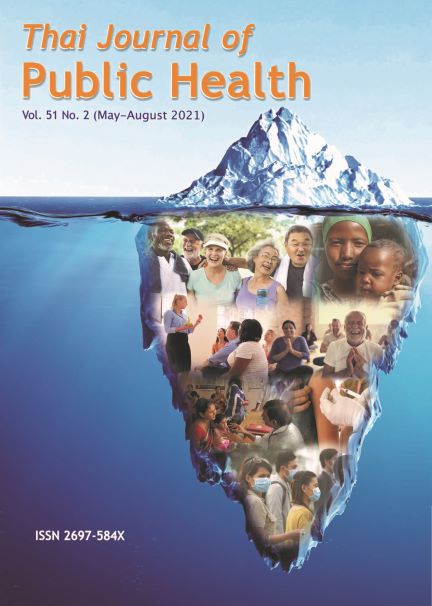Relationship between Factors Related to Implementation of Haze Control Measures and Respiratory Health of Communities
Keywords:
Haze, Respiratory diseases, Haze control measure, Northern ThailandAbstract
Haze smoke has been a seasonal problem in upper northern Thailand for more than a decade. Biomass burning of agricultural wastes and forest fire are significant sources of haze smoke. Haze smoke regularly occurs in the summer seasons. The local authorities in the haze-smoke affected areas comprehensively implement various kinds of measures to reduce haze smoke and its impacts on human health.
We conducted an ecological study to examine the relationship between the factors related to the implementation of haze smoke control measures and the respiratory health of the communities residing in Mueang districts (urbanized areas) of five provinces located in upper northern Thailand, i.e., Chiang Mai, Chiang Rai, Mae Hong Son, and Nan. The factors related to haze smoke control implementation which were the focus of this study included the number of different interventions implemented, primary organizations responsible for the intervention plans, implementation periods, budget allocation, target group of the implementation, and implementation frequency. We extracted these data for 2015 to 2016 from the governmental data records available at local authorities who are responsible for haze smoke control prevention and control, i.e., local hospitals, Local Administrative Authorities, and Provincial Natural Resources and Environment Departments in the study areas. In the same period, we obtained data on outpatient visits due to respiratory diseases (ICD10: J00-J99) and data on their residential areas from hospital records available at the Strategy and Planning Division, Ministry of Public Health.
The five study districts consisted of 732 villages, of which 542 and 532 provided complete data in 2015 and 2016, respectively, for use in the analysis. We used a Poisson regression model to assess the relationship between the factors related to haze smoke control implementation in the villages and the risk of outpatient visits due to respiratory diseases in the villages, controlling for year, and villages' risk populations for respiratory illnesses, i.e., those aged <5 years and aged 65 years and over. We found a significantly increased risk of respiratory illnesses among villagers residing in the haze-smoke affected areas, which were associated with multiple factors. These factors included implementing less than four different haze control interventions per year, not implementing interventions all-year-round, no budget allocation for the implementation, implementation less than 30 times per year, haze control implementation under the annual plan of provincial or local authorities, and non-community targeted implementations.
In conclusion, the findings indicate that the communities’ respiratory health is associated with a range of factors involving haze control implementation of local governmental agencies in haze smoke areas. The results provide beneficial information for local authorities responsible for haze smoke prevention and control and community health to improve the effectiveness of haze control measures in the affected areas. Further studies to confirm the findings are suggested when data on socio-economic status, cultural status, and environmental conditions of communities in the haze-smoke affected areas become available, so that the effects of these factors can be evaluated.
References
Pollution Control Department. Summary of pollution situation of Thailand in 2007. Available from: http://www.pcd.go.th/public/Publications/print_report.cfm?task=report2550, accessed 20 Apr, 2020. (In Thai)
Pollution Control Department. Report of situation of pollution of Thailand in 2009. Available from: http://www.pcd.go.th/public/Publications/print_ report.cfm?task=pcdreport, accessed 20 Apr, 2020. (In Thai)
Pollution Control Department. Report of situation of pollution of Thailand in 2010. Available from: http://www.pcd.go.th/info_serv/Eco_Asean/files/Report_Thai2554.pdf, accessed 20 Apr, 2020. (In Thai)
Pollution Control Department. Report of situation of pollution of Thailand in 2013. Available from: http://www.pcd.go.th/public/Publications/print_report.cfm?task=pcdreport2557, accessed 20 Apr, 2020. (In Thai)
Pollution Control Department. Report of situation of pollution of Thailand in 2015. Available from: http://www.pcd.go.th/public/Publications/print_report.cfm?task=pcdreport-58final, accessed 20 Apr, 2020. (In Thai)
Vajanapoom N, Kooncumchoo P, Thach T-Q. Acute effects of air pollution on all-cause mortality: a natural experiment from haze control measures in Chiang Mai Province, Thailand; 2019. (In Thai)
Cascio WE. Wildland fire smoke and human health. Sci Total Environ 2018; 624:586-95.
Liu JC, Pereira G, Uhl SA, Bravo MA, Bell ML. A systematic review of the physical health impacts from non-occupational exposure to wildfire smoke. Environ Res 2015; 136: 120-32.
Reid CE, Brauer M, Johnston FH, Jerrett M, Balmes JR, Elliott CT. Critical review of health impacts of wildfire smoke exposure. Environ Health Perspect 2016; 124(9): 1334-43.
Strategy and Planning Division, Office of Permanent Secretary, Ministry of Public Health. Report of illness in 1984 -2020. Available from: http://bps.moph.go.th/new_bps/healthdata, accessed 2 Oct, 2020. (In Thai)
Vajanapoom N, Langkulsen U, Doran R, Homkum N. Community health vulnerability in haze areas in northern Thailand; 2019. (In Thai)
Kollanus V, Tiittanen P, Niemi JV, Lanki T. Effects of long-range transported air pollution from vegetation fires on daily mortality and hospital admissions in the Helsinki metropolitan area, Finland. Environ Res 2016; 151: 351-8.
Delfino RJ, Brummel S, Wu J, Stern H, Ostro B, Lipsett M, et al. The relationship of respiratory and cardiovascular hospital admissions to the southern California wildfires of 2003. Occup Environ Med 2009; 66(3): 189-97.
Vajanapoom N, Kooncumchoo P, Thach TQ. Acute effects of air pollution on all-cause mortality: a natural experiment from haze control measures in Chiang Mai Province, Thailand. PeerJ 2020; 8: e9207.
Downloads
Published
Issue
Section
License
Creative Commons License CC-BY-ND


